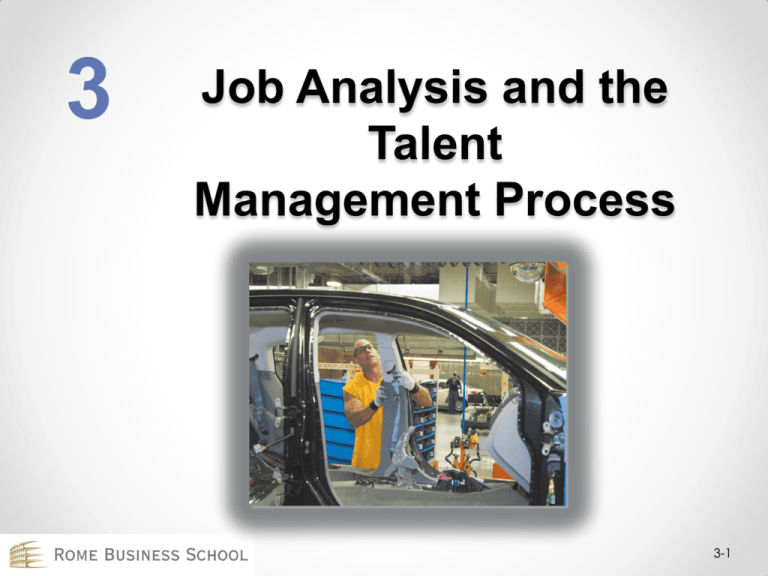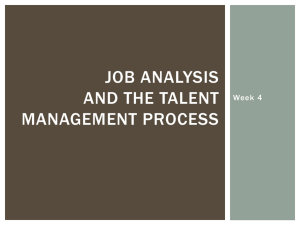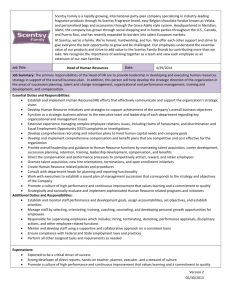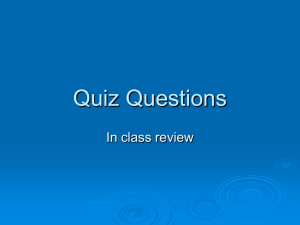What is job analysis? - Rome Business School
advertisement

3 Job Analysis and the Talent Management Process 3-1 Learning Objectives 1. Explain why talent management is important. 2. Discuss the nature of job analysis, including what it is and how it’s used. 3. Use at least three methods of collecting job analysis information, including interviews, questionnaires, and observation. 3-2 Learning Objectives 4. Write job descriptions, including summaries and job functions, using the Internet and traditional methods. 5. Write a job specification. 6. Explain competency-based job analysis, including what it means and how it’s done in practice. 3-3 Explain why talent management is important. 3-4 What is talent management? • We can define talent management as the goal-oriented and integrated process of planning, recruiting, developing, managing, and compensating employees. 3-5 The Talent Management Process • Talent management is a process consisting of the following steps: 1.Decide what positions to fill 2.Build a pool of job candidates 3.Application forms 4.Use selection tools 5.Make an offer 6.Orient, train, and develop 7.Appraise 8.Reward and compensate 3-6 The Talent Management Process o Tasks as parts of one unified process o Goal-directed o Uses the same “profile” o Segments and manages employees o Integrates/coordinates all talent management functions 3-7 Review • Thought of as linear process • Definition • Managing talent effectively 3-8 Discuss the nature of job analysis, including what it is and how it’s used. 3-9 What is job analysis? • Job analysis is the procedure through which you determine the duties of the positions and the characteristics of the people to hire for them. 3-10 The Basics of Job Analysis • Work activities • Behaviors • Machines, tools, equipment, and work aids • Performance standards • Job context • Human requirements 3-11 Uses of Job Analysis Information • • • • Recruitment and selection Performance appraisal Compensation Training 3-12 Conducting a Job Analysis 1. 2. 3. 4. 5. 6. How will information be used? Background information Representative positions Collect and analyze data Verify Job description and specification 3-13 Job Analysis Guidelines • A joint effort • Clarity of questions and process • Different job analysis tools 3-14 Review • • • • The basics of job analysis Uses of job analysis information Conducting a job analysis Job analysis guidelines 3-15 Use at least three methods of collecting job analysis information, including interviews, questionnaires, and observation. 3-16 Collecting Job Analysis Information • • • • • • Interviews Questionnaires Observation Diary/logs Quantitative techniques Internet-based 3-17 Collecting Job Analysis Information – Interviews • The Interview o Typical questions o Structured interviews o Pros and cons o Interviewing guidelines 1. Quickly establish rapport. 2. Use a structured guide. 3. Ask the worker to list his or her duties in order of importance and frequency of occurrence. 4. Review the information with the worker’s immediate supervisor and with the interviewee. 3-18 Review • • • • • • Interviews Questionnaires Observation Diary/logs Quantitative techniques Internet-based 3-19 Write job descriptions, including summaries and job functions, using the Internet and traditional methods. 3-20 What is a job description? • The most important product of job analysis is the job description. A job description is a written statement of what the worker actually does, how he or she does it, and what the job’s working conditions are. 3-21 Writing Job Descriptions • • • • Job identification Job summary Relationships Responsibilities and duties o Authority • Performance standards & working conditions • Job specifications 3-22 Write a job specification. 3-23 What is a Job Specification? • A job specification lists the knowledge, abilities, and skills required to perform the job satisfactorily 3-24 Difference between Job Description and Job Specification • A job description is the duties to be performed. A job specification is what requirements are necessary to perform the task. 2-25 Writing Job Specifications • • • • Trained vs. untrained Judgment Statistical analysis Task statements 3-26 Review • Job descriptions o Identifying the job, summary, relationships o Responsibilities, duties, standards • Specifications 3-27 Explain competency-based job analysis, what it means, and how it’s done. 3-28 What are competencies? • Competencies are observable and measurable behaviors of the person that make performance possible. 3-29 What is Competency-based job analysis? • Competency-based job analysis means describing the job in terms of measurable, observable, behavioral competencies 3-30 How to write Competencies-based job descriptions • Instead of compiling lists of job duties, you will ask, “In order to perform this job competently, the employee should be able to…” 3-31 Review • • • • Observation Measurement Example – work teams Job profiles 3-32









